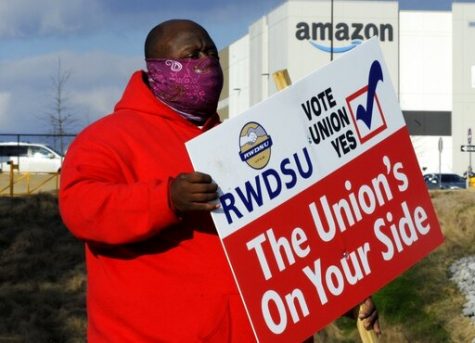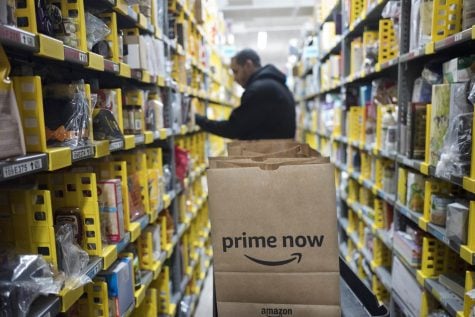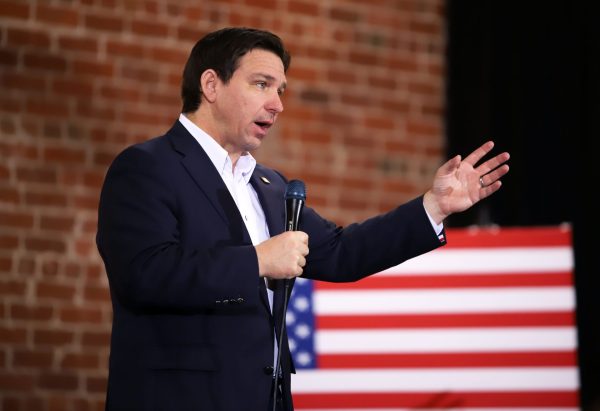Pandemic showcases how corporations take advantage of their ‘essential workers’
AP for The DePaulia
Manuwara Begun, 46, sorts out garbage collected from households in New Delhi, India, Tuesday, March 9, 2021. Begun lives in a cardboard hut behind a five-star hotel in the heart of New Delhi and feels the inequity keenly. Trash pickers often find it hard to get vaccines because they are not considered by the government to be essential workers or cannot afford to wait at overburdened public hospitals for free shots. Chintan estimates that each year, those like her save the local government over $50 million and eliminate over 900,000 tons of carbon dioxide by diverting waste away from landfills. (AP Photo/Manish Swarup)
As the country begrudgingly celebrates the one-year mark of quarantine, there has been a widespread reflection. Students have recalled thinking they’d scored just an extra week or two of spring break, while many adults looked forward to working from home for a spill.
Essential workers, however, did not have such a luxury. Greeted with mobs of customers, more hours and no wage or safety increases, they found themselves on the front lines of a pandemic no one expected.
“When the pandemic first hit, a vast majority of the public started working from home,” said Hunter Rose, a Walgreens employee in Lincoln Park. “Essential employees — everyday retail workers — were still showing up and putting their life on the line to support themselves in an unknown environment.”
Rose said he witnessed employees being taken advantage of through a lack of personal protective equipment at the start of the pandemic, decreasing staff size with an increase in workload and neglecting to provide adequate hazard pay.
These failures of employee safety become more dangerous when their demographics are considered. A majority of essential workers are low-income and low-educated, with only 30 percent having a college degree, meaning they were not only forced into these positions by their job descriptions but for survival as well.
Some companies, like Tyson Foods Inc., were quick to return to pre-pandemic work absence policies as early as June 2020. The company began penalizing workers who refused to come to work due to fear of contracting the virus.

But the Covid-19 policies weren’t so idyllic either. Employees could stay home without losing their job, but they would go unpaid as a result — which, for many struggling to make ends meet even without the effects of the pandemic, was not an option.
Those who came to work were often met with unsafe work conditions. Companies like Amazon failed to maintain social distancing in many of their distribution sites, having as many as 200 workers in a break room at once. The company also did not provide employees with updates on outbreaks within facilities, nor did they report those cases to local health departments.
Additionally, many companies failed to provide clear guidelines on how workers were to conduct the store safely and follow mandated guidelines.
Walgreens, for instance, reportedly provided inconsistent instructions and has backtracked mandates on a seemingly routine basis. There were reports at the start of the pandemic that the company was hesitant to allow employees to wear masks. Then, with the rollout of the mask requirement, the company began requiring employees of the store to wear masks and social distance.
Several stores in the city of Chicago were routinely checked by members of local health departments and received fines if employees failed to corral customers. After incidents where customers refusing to mask up became violent, the store changed its tune by telling employees not to confront customers instead.
“I am sure frontline workers in [essential businesses] would have appreciated stronger corporate guidance about how to treat non-compliant guests,” said Grace Lemmon, a DePaul professor of business management. “For example, maybe [stores] needed a ‘czar of compliance’ whose sole job was to enforce mask-wearing and safety, taking some of the task work — not to mention emotional labor — off the employees.”
Lemmon says in her own experience, the biggest obstacle for essential workers is this expectation to police members of the general public to follow safety guidelines.
“I remember doing a quick return at a local store and a customer refusing to pull her mask about her nose despite a very clear sign in front of the store,” Lemmon said. “The employees urged her to cover herself, but I could sense a hesitation: Did they want to confront this woman? Did they want to make a scene? Irritate a potentially lucrative customer? The customer rolled her eyes, made a half-hearted attempt to pull it up, but did not care less when it again fell back below her nose.”

Jaclyn Jensen, a fellow business management professor at DePaul, reiterated the importance of providing clear, realistic expectations for essential workers.
“It is very important for the organization to provide guidance on how employees should respond — there should be a standard response that all employees are trained to follow, versus expecting the employee to determine on their own what is best to do,” Jensen said. “Standard rules for handling situations like this, with the employee feeling like the organization has their back and is willing to support them, is critical to making essential workers feel valued and respected.”
There are several factors that could have resulted in essential workers feeling unappreciated.
Money is a large component. With many essential businesses providing the “fear buy” itms like toilet paper, zinc tablets, etc., larger corporations can’t miss the opportunity to get lax.
Furthermore, essential workers allow the rest of the population to stay home. Amazon offers same-day delivery. Walgreens has begun offering curbside pickup. Pharmacies from multiple corporations offer home delivery as well. Not to mention these workers are fueling a bruised economy, allowing other businesses and professions unable to return in person to take a hit.
But the simple matter is, essential workers are just like the rest of the country. They have families, pre-existing conditions and bills to pay. Unappreciated workers stress that “essential” is not synonymous with “expendable.”
Lemmon shared three key ways corporations could and should be stepping up for their employees: hazard pay, a designated individual to enforce regulations and empathy.
Referencing a Vox article, she shared that, “The person setting store-level policy for those workers should, at minimum, work two weeks in their shoes — that policymaker should be paid like them, experience the physical labor they experience, experience interactions with the public like they experience, experience the rewards and punishments that guide their behavior, experience the same frills, [such as] break rooms and breaks. After these two weeks, then set policy in the most humane way possible.”
She continued with what people outside of corporate America can offer these workers.
“I believe much was written about how Covid-19 disproportionately impacted lower-income people relative to upper-middle-income people,” Lemmon said. “I hope people in this echelon — of which I am one — recognize that they play an important role in more equitably distributing core resources, including safety and wages.”
Lemmon explained that individuals can do this by tipping a bit extra — and in cash. She encourages people to take a look at how they can redistribute their wealth and help out those putting themselves at risk, who don’t have a choice.
But after a year of hardly any appreciation, equity and disrespect, some essential workers are less than hopeful that their luck will turn.
Rose believes the pandemic has revealed an ugly truth about society’s perception, value and appreciation of its essential workers. He hopes that society can eventually recognize what was sacrificed so this mistreatment isn’t repeated.
“I myself am not even aware of all steps that could be taken to achieve a better workplace for essential workers,” Rose said. “… [But] it is time we shed more light on this subject and start challenging the status quo as workers to obtain better rights from our employers that work better for us.”
So, while many are reflecting on time during the pandemic, essential workers are asking that their efforts not be forgotten.












